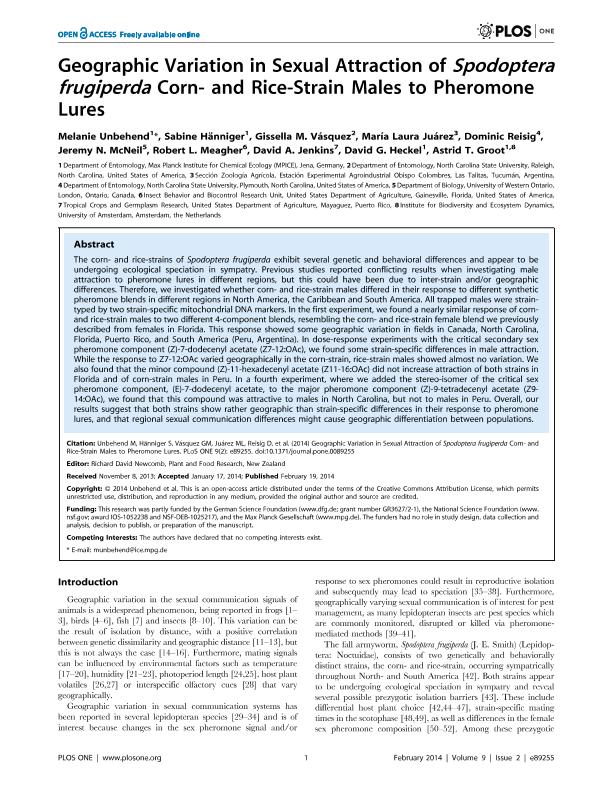Mostrar el registro sencillo del ítem
dc.contributor.author
Unbehend, Melanie
dc.contributor.author
Hänniger, Sabine
dc.contributor.author
Vasquez, Gissella M.
dc.contributor.author
Juárez, María Laura

dc.contributor.author
Reisig, Dominic
dc.contributor.author
Mcneil, Jeremy N.
dc.contributor.author
Meagher, Robert L.
dc.contributor.author
Jenkins, David A.
dc.contributor.author
Heckel, David G.
dc.contributor.author
Groot, Astrid T.
dc.date.available
2016-08-22T20:37:28Z
dc.date.issued
2014-02
dc.identifier.citation
Unbehend, Melanie; Hänniger, Sabine; Vasquez, Gissella M.; Juárez, María Laura; Reisig, Dominic; et al.; Geographic Variation in Sexual Attraction of Spodoptera frugiperda Corn- and Rice-Strain Males to Pheromone Lures; Public Library Of Science; Plos One; 9; 2; 2-2014; e89255-e89255
dc.identifier.issn
1932-6203
dc.identifier.uri
http://hdl.handle.net/11336/7279
dc.description.abstract
The corn- and rice-strains of Spodoptera frugiperda exhibit several genetic and behavioral differences and appear to be undergoing ecological speciation in sympatry. Previous studies reported conflicting results when investigating male attraction to pheromone lures in different regions, but this could have been due to inter-strain and/or geographic differences. Therefore, we investigated whether corn- and rice-strain males differed in their response to different synthetic pheromone blends in different regions in North America, the Caribbean and South America. All trapped males were strain typed by two strain-specific mitochondrial DNA markers. In the first experiment, we found a nearly similar response of corn and rice-strain males to two different 4-component blends, resembling the corn- and rice-strain female blend we previously described from females in Florida. This response showed some geographic variation in fields in Canada, North Carolina, Florida, Puerto Rico, and South America (Peru, Argentina). In dose-response experiments with the critical secondary sex pheromone component (Z)-7-dodecenyl acetate (Z7-12:OAc), we found some strain-specific differences in male attraction. While the response to Z7-12:OAc varied geographically in the corn-strain, rice-strain males showed almost no variation. We also found that the minor compound (Z)-11-hexadecenyl acetate (Z11-16:OAc) did not increase attraction of both strains in Florida and of corn-strain males in Peru. In a fourth experiment, where we added the stereo-isomer of the critical sex pheromone component, (E)-7-dodecenyl acetate, to the major pheromone component (Z)-9-tetradecenyl acetate (Z9-14:OAc), we found that this compound was attractive to males in North Carolina, but not to males in Peru. Overall, our results suggest that both strains show rather geographic than strain-specific differences in their response to pheromone lures, and that regional sexual communication differences might cause geographic differentiation between populations.
dc.format
application/pdf
dc.language.iso
eng
dc.publisher
Public Library Of Science

dc.rights
info:eu-repo/semantics/openAccess
dc.rights.uri
https://creativecommons.org/licenses/by-nc-sa/2.5/ar/
dc.subject
Sexual Communication
dc.subject
Fall Armyworm
dc.subject
Corn- And Rice-Strain
dc.subject
Synthetic Pheromone Lures
dc.subject
Field Experiments
dc.subject
Dose-Response Experiments
dc.subject.classification
Zoología, Ornitología, Entomología, Etología

dc.subject.classification
Ciencias Biológicas

dc.subject.classification
CIENCIAS NATURALES Y EXACTAS

dc.title
Geographic Variation in Sexual Attraction of Spodoptera frugiperda Corn- and Rice-Strain Males to Pheromone Lures
dc.type
info:eu-repo/semantics/article
dc.type
info:ar-repo/semantics/artículo
dc.type
info:eu-repo/semantics/publishedVersion
dc.date.updated
2016-08-17T15:40:32Z
dc.journal.volume
9
dc.journal.number
2
dc.journal.pagination
e89255-e89255
dc.journal.pais
Estados Unidos

dc.journal.ciudad
San Francisco
dc.description.fil
Fil: Unbehend, Melanie. Instituto Max Planck Institut Fur Chemische Okologie; Alemania
dc.description.fil
Fil: Hänniger, Sabine. Instituto Max Planck Institut Fur Chemische Okologie; Alemania
dc.description.fil
Fil: Vasquez, Gissella M.. University Of North Carolina; Estados Unidos
dc.description.fil
Fil: Juárez, María Laura. Gobierno de Tucumán. Ministerio de Desarrollo Productivo. Estación Experimental Agroindustrial Obispo Colombres; Argentina. Consejo Nacional de Investigaciones Científicas y Técnicas. Centro Científico Tecnológico Tucumán; Argentina
dc.description.fil
Fil: Reisig, Dominic. University Of North Carolina; Estados Unidos
dc.description.fil
Fil: Mcneil, Jeremy N.. University of Western Ontario. Department of Biology; Canadá
dc.description.fil
Fil: Meagher, Robert L.. United States Department Of Agriculture; Estados Unidos
dc.description.fil
Fil: Jenkins, David A.. United States Department of Agriculture; Estados Unidos
dc.description.fil
Fil: Heckel, David G.. Instituto Max Planck Institut Fur Chemische Okologie; Alemania
dc.description.fil
Fil: Groot, Astrid T.. University Of Amsterdam; Países Bajos. Instituto Max Planck Institut Fur Chemische Okologie; Alemania
dc.journal.title
Plos One

dc.relation.alternativeid
info:eu-repo/semantics/altIdentifier/url/http://journals.plos.org/plosone/article?id=10.1371%2Fjournal.pone.0089255
dc.relation.alternativeid
info:eu-repo/semantics/altIdentifier/url/https://www.ncbi.nlm.nih.gov/pmc/articles/PMC3929749/
dc.relation.alternativeid
info:eu-repo/semantics/altIdentifier/doi/10.1371/journal.pone.0089255
dc.relation.alternativeid
info:eu-repo/semantics/altIdentifier/doi/http://dx.doi.org/10.1371/journal.pone.0089255
Archivos asociados
